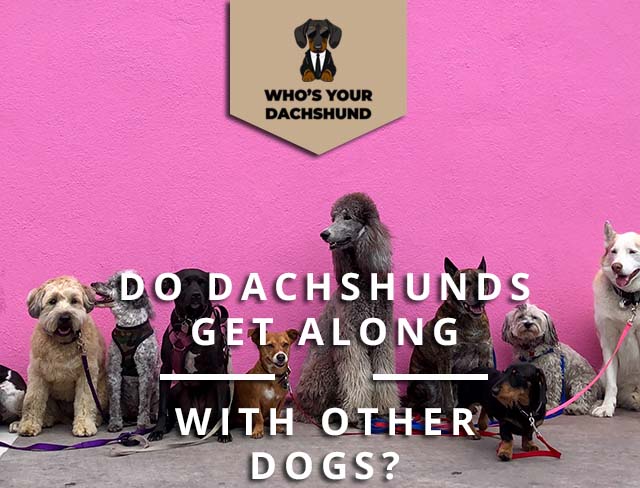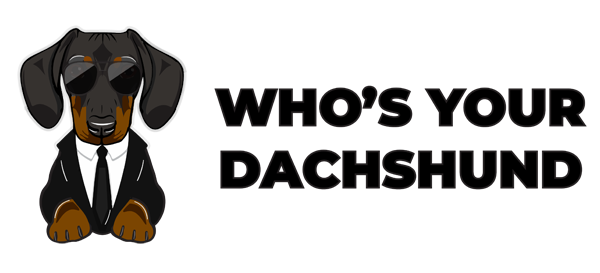
Dachshunds are excellent at getting along with other animals, including other dogs. However, it varies from one individual to another.
Dachshunds are the best dog, if you have a dachshund and want to know more about whether they get along with other dogs, please see the following article for more information. We cover what breeds of dogs are the best at getting along with dachshunds and which breeds of dogs are not quite so good at getting along with them. This article covers tips for preparing your dog before introducing them to the new dog and raising them properly to learn proper social skills together.
It’s important to remember that each Dachshund is different and will react when meeting another pet. If you are looking for information about introducing your dog to another animal, here is one approved method that has worked for others. You can use this process to introduce any pet with one or multiple dogs.
Start Before You Bring Home A New Dog:
Ideally, you should start the introduction process at least two weeks before bringing a new dog home. If you’ve found a dog to adopt, start getting your current dog prepared for the latest addition to its family. By introducing the idea of another dog coming into the household well in advance of when it’s supposed to happen, your pet will begin accepting this change much sooner and be less stressed out when it happens.
Step One: Cuddle With The New Dog And Ignore Your Current Pet:
To avoid having your current pet become jealous, the first thing you want to do is to ignore it. You then want to snuggle with the other dog and tell it that it has a special place in your life. That will help your dog understand that even though there will be another pet in the house, they are still extraordinary.
Step Two: Walk With Both Dogs On Leashes:
It would be best if you started walking both dogs on leashes at this point but keeping them far enough apart so that they cannot interact much with one another. By doing so, your dog will get the message that you’re striving to get along with another dog. Getting them used to each other at a distance and on leashes will help them interact better when introduced in the house.
Step Three: Get Both Dogs Together In The House:
At this point, you should bring both animals into the same room, preferably one where they can’t knock into one another or get at anything that might encourage them to fight. The best place for this introduction is probably the kitchen since most kitchens have enough room for both dogs if they stay on their sides of the room. Let them get used to each other from a distance by sniffing the air but not interacting much.
Interacting With Your Current Pet The Day You Adopt A New Dog:
Let your current pet see that you are now spending time with the new dog. Spend as much time grooming your current pet to understand that things won’t change too much. Make sure to ask others in your family to spend time paying attention to your existing pet, so there are plenty of cues for it that nothing will change in its life.
Introducing A New Dog To Your Present Dog:
If you’ve followed the tips in this article, you should have already gotten your current dog used to the idea that there will be another one in the house. You have ignored your existing dog for a while now. It begins to realize there will soon be another animal coming in its place. They’ll be much more likely to accept the new dog into its life and your family with this understanding. If you could not get them used to this idea before introducing the new pet, you may want to go back and try again.
Bring the two dogs onto the same level of the house so that they can meet face to face. Put them both on leashes and then let them see each other closely for a few moments. Once that is done, you need to back away so that the dogs have their space again. This time, let them sniff each other through their leashes for a few minutes before letting them go free. They may start snapping or even growling at one another, but don’t interfere. That is just a natural reaction, and they must learn to control themselves.
With both dogs still on their leashes, start to move them around the room together, being careful not to let them get tangled. At this point, you should walk both dogs around the room while allowing them to sniff each other as much as possible. It will help them understand that each one has its place in your life and can live together without causing any trouble. After about half an hour of this, you should let the dogs go free and interact freely with each other but continue to watch very closely. If you see anything wrong, you’ll need to be able to prevent it from getting worse.
Are Dachshunds Good With Other Dogs?
Dachshunds are not just good with other dogs, and they love company. They are loyal and kind-hearted, making them good family pets. For instance, the mini Dachshund is a favorite of many families looking for a trustworthy and protective dog. You can find dachshunds good with other dogs and many other animals.
Are dachshunds good with cats? One of the best things about dachshunds is that they are good with cats and dogs. They are by nature wary and observant, which makes them an excellent watchdog for the home.
Dachshunds can indeed be trained to follow commands, and some even enjoy interactive games, so if you would like your Dachshund to play nicely with your cat or young children, it is possible to teach your Dachshund how to do this successfully.
Dogs That Get Along With Dachshunds
The American Eskimo
The American Eskimo Dog is an intelligent, independent, and gentle companion for the Dachshund. It is generally considered to be a loyal family pet. They have a high level of energy and love to play and run. This breed does not fare well when left alone for long periods.
The Australian Shepherd
It is a gentle dog with the heart of an adventurer. It has been bred to think independently and work as a team with other Aussies and people. These dogs are susceptible to their surroundings, making them somewhat shy around strangers and cautious of new experiences.
The Border Collie
It is one of the smartest dog breeds globally and makes excellent working dogs. They have an independent nature and are not recommended for first-time dog owners. This intelligent breed needs a job to complete and plenty of physical activity.
The Beagle
The “little hound” is often known as a sweet-natured, gentle, happy-go-lucky dog breed. The Beagle loves everyone, including other dogs, with its fun-loving and trusting nature. These dogs have a strong background of working in packs with other hounds, giving them an amiable personality.
The Boxers
This kind of dog can be stubborn at times, but they are highly affectionate towards their family members. They like the company of other dogs and are gentle with them. Boxers are very obedient, intelligent, and friendly. This breed loves to play and enjoys time with its family.
The Bulldog
The Bulldog is gentle, loving, and curious about almost everything that goes on around him. He enjoys other dogs’ company, but he may become aggressive towards smaller breeds. The Bulldog requires plenty of exercises to prevent obesity, such as long walks or jogs, a large yard for playtime, toys for chewing, and plenty of rest during the day.
The Collie
The Collie has a naturally gentle and sweet nature. This breed has an easy-going personality and is not aggressive in any way. They are good with children and other dogs. The Collie should have plenty of space to run, exercise, and play. It is not recommended for apartment living because it needs an active lifestyle to stay at its best.
Does Your Doxie Want A Companion Dog?
There are many reasons why people should get a second dog in addition to their Dachshund. Among the most persuasive is that dogs can protect larger animals and keep watch while the family is away. If you choose a smaller dog for a companion for your wiener dog, he or she will be less intimidated by the little dachsie’s size and seems to inspire more confidence in other dogs than his or her more enormous owner does.
Housetraining
Your doxie will need to learn that you are in charge of such matters from day one without becoming insecure or resentful about potty training. A companion dog who has not been previously housetrained may be the best choice here since both of your dachshunds can learn together and benefit from each other’s cooperation and discipline.
How do you know that a companion dog will be any more receptive to training than the dachshunds already in your household or perhaps the potential new rescue dog? Well, it’s worth a try because there are some interesting differences between the housetraining behavior of cats and dogs.
Training your Dachshund to do tricks like rollover or dance is fun for both of you. If you are thinking of getting a second dachshund, there is the advantage of having a second dog work within the training process. It helps if one of your dogs already knows how to retrieve and keep the object until you arrive to reward the achievement.
You can begin enticing other dogs into your home by feeding them their favorite food treats while your dachshunds watch from inside their crates. A feeding bowl or even an empty tin can or plastic margarine tub will do (but no metal, since some dogs have learned it is possible to chew through it).
Do Doxies Play Well With Some Breeds And Not Others?
Doxies are small, friendly dogs that make desirable companions for some breeds and not others. Like a little dog, the Dachshund is naturally going to be more comfortable around other small breeds. Still, no matter the dog’s size, a Dachshund with an alpha personality tends to be aggressive toward other animals.
A Dachshund’s Personalities
All dogs have their personalities and need to be treated accordingly, considering the breed traits. The Dachshund has its own unique set of character traits: stubbornness, independence, loyalty, and protectiveness. These character traits make them excellent pets for people who can spend time socializing them from an early age.
Dachshunds are naturally very playful, making them good companions for active families. They have a natural need to dig and may become destructive if you are not willing to supply them with an appropriate outlet for this trait. A Dachshund will need plenty of exercise and attention to stay well-behaved.
A Dachshund’s Size
Doxies typically weigh between 16 and 32 pounds when fully grown. They are relatively small dogs that larger dogs easily overpower, so it is essential to keep your dog in mind when deciding who is the best fit for your family.
The Dachshund Temperament…
Doxies are friendly and outgoing dogs that do well with other household dogs, primarily raised together. However, puppies can possess their food and toys, so you should be sure your puppy doesn’t become aggressive in playing with or eating their things.
Dachshunds have an instinct to chase small animals like rabbits, squirrels, and cats. This behavior is typically gotten out of them as puppies by socializing them around other animals early on. If your Dachshund still behaves in this way after staying with you for a long time, you might consider keeping the cat inside unless it is supervised outside.
Small Dog Or Small Breed Dog?…
Dachshund size can be comparable to some other dog breeds. A likely animal companion for the Doxie is the Shih Tzu, a small toy breed with a short, silky coat that is somewhat friendly and playful.
Another similar breed to the Dachshund is the Miniature Schnauzer. They have a thick black and gray coat that is also somewhat playful. Miniature Schnauzers can be reserved around strangers, but they are very loyal and affectionate once they warm up to you. They make good companions for active families who want a pet. They can train to do tricks and play outside.
Does Size Matter When Choosing A Dog To Join The Family?
The answer is a definitive “yes.” For some reason, people often overlook their dog’s size when considering which breed to adopt. It can be an easy mistake to make when there are so many beautiful dogs of all shapes and sizes available at shelters. However, if size were truly irrelevant, we wouldn’t see nearly as many heart-breaking stories about dogs being forced to live apart from their families or with new families because of irreconcilable differences with other pets.
Size does matter when introducing a new dog into your household because it can mean the difference between harmony and disaster. Small dogs tend to be more tolerant and patient than larger breeds when living in close quarters with other canines. Besides, they are usually less dominant than large breeds (with very few exceptions). That makes them a perfect match for homes where there are already canine residents.
If you consider adopting a dachshund because of their small size, it is essential to match them with another dog who shares their easy-going temperament.
Dachshunds And Big Dogs — A Mixed Bag!
While smaller dogs tend to get along better with other dogs, almost all mixed-breed dachshunds will get along well with pups that are closer to their size.
A wise choice for your doxie mix would be a dog that is close to or below the miniature Dachshund’s 15 inches in height. There are several reasons why this works out so well for your little guy.
- First, the diminutive size makes it easier for a dachshund to get away from an overzealous playmate. It is easy for them to get pinned underneath a larger dog.
- Second, they aren’t likely to pick on or bully other small dogs when looking for playmates. They are more likely to join in!
- Third, they will not be at risk of being injured by other large dogs that can potentially do a lot of damage. Breeds commonly recommended as companions for miniature dachshunds include beagles, pugs, and Pomeranians.
However, some breeds can cause problems for tiny dachshunds.
Avoid Dobermans, Rottweilers, German Shepherds, Labrador Retrievers.
Size Matters When Choosing A Dachshund Breeding Partner
If you are looking to breed your miniature dachshund, you should consider a doxie in roughly the same size category as your little guy or gal. Not only will they physically be able to breed together if they are close in size, but they will also have a better chance at bonding than with a larger or smaller dog.
Does Age Matter?
Age matters. As we get older, it seems we have pulled away from everything that once seemed so important. As we live our lives, the world becomes more complicated and less forgiving. The weight of responsibility is heavy, but we can survive. The simple
things of youth are gone, but their memory is a light that shines in our hearts. The joy of living is still there if you look hard enough. Do dachshunds get along with other dogs? Yes and no.
Companionship
One of the dachshund breeds’ defining characteristics is companionship; Doxies love to be around people and other dogs. This trait defines them as companions rather than human’s best friend; they love everyone equally—which can be a good thing or a bad thing depending on your point of view.
What Doxies Need
Doxies are an excellent choice for someone who wants a dog that will be around all the time. They do better in a home with constant attention than when left alone for long periods.
How Many?
The number of dachshunds you should have depends upon how you want them to live. Two adult dachshunds are fine if you want them to be together regularly, but even adult dachshunds need some time away from each other to avoid problems. One adult and one puppy is usually the best combination but never put two puppies together unless you are prepared for some rough times.
Other Animals
Dachshunds do not like other dogs of the same sex. They interact well with other species and have an incredibly close relationship with cats. They generally don’t like to be around large dogs but will get along well with slightly smaller ones (Labrador Retrievers and similarly sized companions).
What To Expect
Expect some problems if you put two adult dachshunds together. They are extremely territorial animals and fight fiercely for their territory. The result can be a yelping dog, a trainer’s bill, or both. If you are considering adopting two dachshunds, please think again.

